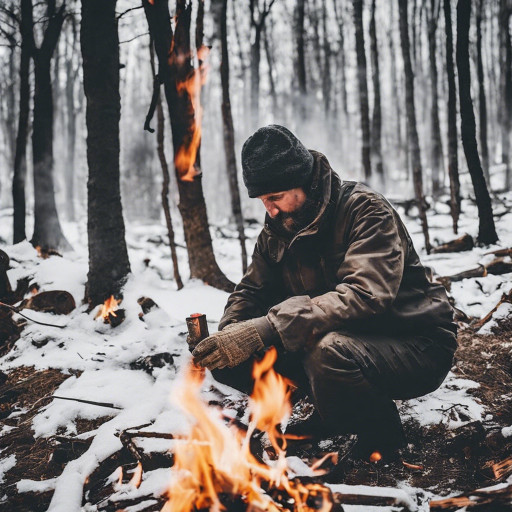Master Essential Fire Starting Techniques for Cold Weather Survival
Starting a fire in freezing temperatures is not just a skill; it’s a crucial survival technique that can mean the difference between life and death in harsh winter conditions. The biting chill and relentless winds of winter can create a perilous environment, making the ability to create warmth, light, and prepare food essential. As a passionate survivalist, you appreciate the critical role that fire plays in sustaining life. However, the unique challenges presented by icy conditions demand specialized strategies and techniques. In this comprehensive guide, we will delve into the most effective methods to successfully ignite a fire in cold weather, empowering you with the expertise to overcome winter’s icy grip and thrive in the wilderness.
Essential Fire Starting Gear: Equip Yourself for Success
Before you set out on your winter adventures, it is imperative to gather the appropriate gear and supplies that can dramatically boost your chances of survival in the wild. A well-organized fire-starting kit can be the key to overcoming the formidable challenges posed by severe weather. Make sure to include the following essential items in your survival kit:

a. Reliable Firestarters: Essential tools like waterproof matches, storm-resistant lighters, and fire-starting rods are crucial for ensuring ignition, even in adverse conditions like wind and moisture. Having multiple ignition sources will instill confidence, allowing you to light a fire regardless of the challenges you face.
b. High-Quality Dry Tinder: Finding dry tinder in frigid conditions can be incredibly challenging. To tackle this issue, pack highly flammable materials like birch bark, fatwood shavings, and cotton balls soaked in petroleum jelly. These items not only ignite quickly but also significantly increase your chances of successfully starting a fire in subzero temperatures.
c. Proper Kindling: To build a strong foundation for your fire, gather dry sticks, twigs, and leaves. Ensuring these materials are completely dry is critical, as any moisture can hinder the ignition process and lead to frustration. Well-prepared kindling is vital for transitioning from tinder to a more robust fire.
d. Sufficient Fuel Supply: Securing dry firewood in cold conditions can be both exhausting and time-consuming. Therefore, having a sufficient stockpile of dry firewood ready in advance is essential for maintaining a steady fire for an extended period, ensuring you stay warm and can cook food comfortably.
Optimizing Fire Location: Choose the Best Spot for Maximum Heat
When temperatures drop, selecting the perfect location for your fire can confer significant advantages. Look for sheltered spots, such as rock formations or dense shrubbery, to minimize exposure to harsh winds. By positioning your fire near a natural windbreak, you can reduce heat loss and improve the likelihood of sustaining a consistent flame. Additionally, consider constructing a small wind-resistant shelter using logs or a tarp to protect the fire from rain and help retain warmth, ultimately enhancing your comfort and safety in the wilderness.
Perfect the Layering Technique: Steps for Creating Effective Fires
One of the most crucial techniques for successfully igniting a fire in cold weather is mastering the layering of your materials. Building a fire that burns steadily requires the effective use of three foundational layers: tinder, kindling, and fuel. Here’s a breakdown of each layer and its importance:
a. Tinder Layer: The first layer, tinder, consists of materials that ignite quickly and easily. Use fine, dry substances like grass, paper, or the previously mentioned birch bark to ensure a strong initial flame. Having a sufficient supply of tinder is critical for achieving successful ignition, especially in cold environments.
b. Kindling Layer: This layer comprises small sticks and twigs that catch fire readily and provide sustained heat. Gradually introduce kindling to your flame, ensuring ample space between pieces to promote airflow and encourage combustion. This step is essential for transitioning from small flames to a larger, stable fire.
c. Fuel Layer: Once a steady flame has been established, progressively add larger pieces of firewood. Ensure the wood is dry, as it will burn longer and generate more heat. Increase the size of the wood pieces gradually, allowing the flames to strengthen before adding larger logs. This strategic approach to layering your fire fosters a stable and sustainable flame.
The technique of layering your fire creates a structured setup that allows the flames to expand and sustain themselves effectively. Always ensure you have an adequate supply of each component readily available to facilitate a smooth transition from tinder to fuel, ensuring a successful fire in challenging conditions.
Enhance Fire Starting Success with Proven Aids and Techniques
In frigid weather, using additional fire-starting aids can significantly improve your chances of igniting a fire against the obstacles posed by low temperatures. Here are some effective methods to consider:
a. Utilizing Fatwood: Often referred to as nature’s firestarter, fatwood is resin-infused pine wood that ignites easily and burns with intense heat. You can collect these naturally occurring sticks from fallen pine trees or purchase them from outdoor supply retailers. A few pieces of fatwood can drastically enhance your chances of starting a fire in exceptionally cold conditions.
b. Alcohol-Based Hand Sanitizer as an Accelerant: Surprisingly effective, alcohol-based hand sanitizer is highly flammable and can act as an accelerant. Applying a small amount to your tinder or kindling can help ignite a fire quickly, even in damp conditions, simplifying the fire-starting process and ensuring warmth when you need it most.
c. Char Cloth for Easy Ignition: Char cloth is a specially prepared fabric that easily ignites from sparks, making it an excellent tool for starting fires using flint and steel or a lighter in challenging situations. Its lightweight and portable nature makes it an ideal addition to your fire-starting kit, guaranteeing that you are always prepared.
Incorporating these fire-starting aids into your cold-weather toolkit can significantly bolster your chances of success when facing particularly challenging conditions, allowing you to adapt effectively to your environment.
Explore Effective Fire Techniques Tailored for Cold Weather Survival
As a committed survivalist, continuously refining your skills is essential for your success. Here are two fire techniques that excel in cold weather conditions:
a. Creating a Swedish Torch: Also known as a Canadian Candle or Finnish Fire Log, the Swedish Torch is an exceptionally effective fire-starting method. This technique offers a stable and long-lasting flame, perfect for combating the chill of winter. To create a Swedish Torch, find a knee-height log and cut several vertical slits along its length. Place tinder in the slits and ignite it. The log will serve as a consistent fuel source, allowing the flame to endure for an extended period, ensuring warmth and safety.
b. Dakota Fire Hole for Windy Conditions: When facing strong winds, the Dakota Fire Hole method is highly effective. This technique involves digging a hole and tunneling horizontally underground to create an airflow vent. This design harnesses wind to boost airflow, resulting in a more efficient fire that is less likely to be disrupted by gusts. Furthermore, the Dakota Fire Hole method effectively reduces visible smoke while conserving fuel, making it an excellent choice for stealthy fire building.
Regardless of the method you choose, always prioritize safety and responsible fire management to minimize risks and ensure a successful fire-starting experience.
Successfully igniting a fire in cold weather requires careful planning and execution. By following these steps—preparing a reliable fire-starting kit, selecting an appropriate location, mastering layering techniques, utilizing fire-starting aids, and embracing specific fire strategies—you will significantly enhance your chances of success. Remember, practice makes perfect, so consistently train to refine your skills and boost your confidence. With these essential tactics for igniting fires in freezing conditions in your toolkit, you’ll be well-prepared to face even the harshest winters that nature has to offer. Stay warm, prioritize your safety, and keep the flames of survival alive!
The post Fire Starting Methods for Survivalists in Cold Weather appeared first on Survival Bite.
The Article Fire Starting Techniques for Cold Weather Survival Was Found On https://limitsofstrategy.com


I really appreciate how you highlighted the importance of fire in winter survival. I remember a backpacking trip where I underestimated how much colder it would get at night. Just having the right gear on hand makes such a difference!
It’s great to hear your thoughts on the role of fire in winter survival. Your experience on that backpacking trip really resonates with many outdoor enthusiasts. The drop in temperature at night can catch even seasoned adventurers off guard. It’s a common scenario to feel comfortable during the day, only to find yourself battling the cold once the sun sets.
It’s interesting how quickly temperatures can drop at night when you’re out in the wild. That experience you shared is quite common for many adventurers; I’ve certainly had nights where I wished I had packed an extra layer or two. Fire definitely becomes a central part of the experience, not just for warmth, but also for cooking and creating a sense of comfort.
The importance of mastering fire-starting techniques in cold weather cannot be overstated, especially when venturing into the wilderness during winter months. In my own experiences, I’ve learned that preparation is just as critical as the techniques themselves. One of the most valuable lessons I picked up in a survival workshop was the significance of selecting the right materials ahead of time.
You bring up a really important point about preparation when it comes to fire-starting in cold weather. I remember attending a camping trip where the temperatures dipped lower than expected, and we had to scramble to find dry kindling. It was a real eye-opener about how much the right materials can make a difference.
You bring up an essential point about preparation. When it comes to fire-starting in cold weather, having the right materials can make all the difference. I’ve found that experimenting with different tinder types, like birch bark or fatwood, during my practice sessions has really paid off. Knowing what works in your specific environment is key.
While I appreciate the emphasis on fire as a survival tool in extreme cold, I think it’s also worth considering the psychological aspects of fire in survival situations. Beyond its practical uses for warmth and cooking, a fire can provide a sense of comfort and security in the harshness of winter.
You raise an important point about the psychological aspects of fire in survival situations. It’s fascinating how something as elemental as fire can shape our mindset in such powerful ways. When you’re out in stark winter conditions, the flickering glow of a fire isn’t just a tool; it becomes a beacon of hope and connection to our surroundings.
I appreciate how you’ve highlighted the importance of mastering fire-starting techniques in cold weather. It’s fascinating to consider how something as fundamental as fire can significantly change our survival prospects in harsh conditions. One tip I’ve found invaluable is to prioritize your fire-starting materials; bringing along dry tinder or even a homemade fire starter can save valuable time and energy.
You make a great point about the value of prioritizing fire-starting materials. When you’re out in the cold, having dry tinder or a homemade fire starter can really change the game. I’ve had my share of cold nights where I underestimated how critical those little details are. It’s not just about having the materials; it’s about knowing what works best for the conditions you’re in.
This is such an essential topic, especially with the rising unpredictability of winter weather we’ve been experiencing in recent years. The ability to start a fire in frigid conditions truly is a lifeline. I remember a winter camping trip a few years back when I underestimated the drop in temperature at night. After a long day of hiking, I found myself struggling to get a fire going with damp kindling and frozen fingers. It was a humbling experience that drove home just how critical it is to be prepared with the right gear and techniques in winter environments.